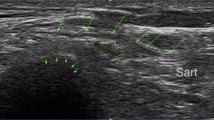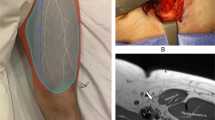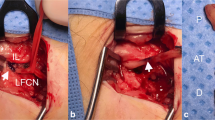Abstract
Objective
Identify sonographic features of the lateral femoral cutaneous nerve (LFCN) in meralgia paresthetica (MP) and report therapeutic outcomes in sonographically confirmed cases.
Materials and methods
Retrospective review of 50 patients with clinically suspected MP and 20 controls. Ultrasounds were reviewed for characteristics of the LFCN and compared between groups. When available, MRIs were reviewed. In cases of sonographically pathologic LFCN, subsequent therapeutic interventions were recorded.
Results
Thirty-five of the suspected MP cases (70%) had ultrasound findings suggestive of MP, 10 (20%) were negative, and in 5 (10%) the LFCN was not seen. Sonographic findings in positive cases included nerve enlargement in all cases (mean cross-sectional area 9 mm2 (standard deviation (SD) ± 5.59) versus 4 mm2 (SD ± 2.31) and 3 mm2 (SD ± 2.31) in negative cases and normal controls, respectively; p < 0.01), nerve hypoechogenicity (30 of 35 cases, 86%), and focal lesion (7 of 35 cases, 20%). Sixteen ultrasounds positive for MP had MRIs with only 4 (25%) reporting a concordant LFCN abnormality (enlargement or T2 hyperintensity). Twenty-five of the 35 (71%) patients with positive sonographic findings for MP had a US-guided LFCN block (local anesthetic ± corticosteroid), with 24 of 25 (96%) patients reporting immediate symptomatic improvement. Eighteen of 35 (51%) underwent LFCN neurectomy or neurolysis, all of whom experienced symptomatic improvement.
Conclusion
Ultrasound is a useful modality for LFCN assessment in clinically suspected MP and is more sensitive for abnormalities than MRI. Nearly all patients who received perineural analgesia and/or neurectomy or neurolysis had symptomatic improvement.






Similar content being viewed by others
References
Rudin D, Manestar M, Ullrich O, Erhardt J, Grob K. The anatomical course of the lateral femoral cutaneous nerve with special attention to the anterior approach to the hip joint. J Bone Joint Surg Am. 2016;98(7):561–7.
Aszmann OC, Dellon ES, Dellon AL. Anatomical course of the lateral femoral cutaneous nerve and its susceptibility to compression and injury. Plast Reconstr Surg. 1997;100(3):600–4.
Ray B, D'Souza AS, Kumar B, et al. Variations in the course and microanatomical study of the lateral femoral cutaneous nerve and its clinical importance. Clin Anat. 2010;23(8):978–84.
Zhu J, Zhao Y, Liu F, Huang Y, Shao J, Hu B. Ultrasound of the lateral femoral cutaneous nerve in asymptomatic adults. BMC Musculoskelet Disord. 2012;13:227.
Grothaus MC, Holt M, Mekhail AO, Ebraheim NA, Yeasting RA. Lateral femoral cutaneous nerve: an anatomic study. Clin Orthop Relat Res. 2005;437:164–8.
Shin YB, Park JH, Kwon DR, Park BK. Variability in conduction of the lateral femoral cutaneous nerve. Muscle Nerve. 2006;33(5):645–9.
Suh DH, Kim DH, Park JW, Park BK. Sonographic and electrophysiologic findings in patients with meralgia paresthetica. Clin Neurophysiol. 2013;124(7):1460–4.
Aravindakannan T, Wilder-Smith EP. High-resolution ultrasonography in the assessment of meralgia paresthetica. Muscle Nerve. 2012;45:434–5.
Chhabra A, Del Grande F, Soldatos T, et al. Meralgia paresthetica: 3-Tesla magnetic resonance neurography. Skelet Radiol. 2013;42(6):803–8.
Acknowledgements
The authors thank GA McKenzie MD, JA Skinner MD, CA Tiegs-Heiden MD, and NS Murthy MD for contributing cases and Desiree J. Lanzino PT, PhD, for her help in editing the manuscript.
Author information
Authors and Affiliations
Corresponding author
Ethics declarations
Conflict of interest
The authors declare that they have no conflict of interest.
Ethical approval
All procedures performed in studies involving human participants were in accordance with the ethical standards of the institutional research committee and with the 1964 Helsinki declaration and its later amendments or comparable ethical standards.
Additional information
Publisher’s note
Springer Nature remains neutral with regard to jurisdictional claims in published maps and institutional affiliations.
Rights and permissions
About this article
Cite this article
Powell, G.M., Baffour, F.I., Erie, A.J. et al. Sonographic evaluation of the lateral femoral cutaneous nerve in meralgia paresthetica. Skeletal Radiol 49, 1135–1140 (2020). https://doi.org/10.1007/s00256-020-03399-8
Received:
Revised:
Accepted:
Published:
Issue Date:
DOI: https://doi.org/10.1007/s00256-020-03399-8




